A trip back in time: MPM 1/48 I-15 vacuform
So why is it the Czechs make such good plastic models?
For those who don't know the answer to that question, the reason why, in the past 24 years since the overthrow of communism and the end of the Cold War, Czech-based companies have come to dominate the limited-run plastic kit industry and set the standards by which other such companies are judged is that they started the industry a good 20 years before that, due to being cut off from western sources for models.
The first time western modelers learned of Czech kits was in the mid-1970s, when Kovzavody Prostjetov, or KP, showed up with injection-molded kits of such aircraft as the MiG-15/17/19, the La-7, the Po-2, and other Soviet types never before modeled, or never before as accurately; the company was created by Czech modeling enthusiasts. The kits had a wealth of surface detail and seemed accurate. Due to the non-convertibility of money between east and west then, the kits were hard to find and harder to come by. I remember exchanging rock 'n' roll albums and Levis jeans with some Czech modelers who also subscribed to esoteric little publications like "Small Air Forces Observer." I like to think that my acts of cultural subversion (small though they were) helped in their way to create The Velvet Revolution.
As anyone knows, even limited-run injection-molded kit making is comparatively the most expensive way to go. Other Czech modelers without access to the tools and equipment needed to copy KP, went into vacuforms. The "common knowledge" among western modelers is that a vacuform can never compete with an injection-molded kit for quality of detail. These Czechs, having no access to the "common knowledge" of the west and being the inheritors of a very long tradition of wood-carving and fine jewelry-making that involves the creation and use of detailed molds, started carving vacuform masters that resulted in a very high-quality product with regard to surface detail. One of the best of these was a little company in Prague known as MPM.
I first became aware of MPM back in 1989, when a friend who regularly traveled to "the other side" returned with three very nice kits for me - the Polikarpov I-15, I-152 and I-153 in 1/48 scale - which he had picked up knowing how I liked that series of airplanes and had often bemoaned the impossibility of ever doing a 1/48 kit. The models looked very convincing when completed, In fact, last month when I was out at Planes of Fame and happened to see them in a new Soviet Aircraft exhibit in the Model Hall, they still looked quite convincing, if a bit aged with dust. I also later obtained their I-16, which to my mind still makes up into the best and most accurate model of that airplane.
I do not know the internal workings of how this happened, but shortly after The Velvet Revolution, MPM split with the two founders going their separate ways. One is MPM and the other is Eduard - they're both still on the cutting edge of quality in detail and the production of models other companies won't touch.
The products of Nikolai Polikarpov's design bureau of the early 1930s were the first indication that the Soviet aeronautical industry was possibly more advanced than many in the west assumed. Thus, the Polikarpov fighters were a nasty surprise to both the Germans and Italians when they appeared as the equipment of the Republican Air Arm in the Spanish Civil War.
Polikarpov's designs were evolutionary rather than revolutionary, and there was nothing seen as out of the ordinary in the biplane fighter whose prototype first flew in October 1933. Powered by an imported Wright SGR-1820-F-3 Cyclone which offered 630 hp at sea level and 715 hp at 6,990 ft., it had 50 percent more power than the I-5 it was to replace, which had been Polikarpov's first successful design (as well as his ticket out of detention by the KGB on charges of "sabotage" after being accused of exercising insufficient energy in bringing assigned work to fruition). With a wing loading of 11.89 lb/sq ft and increased power and a 4 gun armament with 500 rpg for the upper two and 1,000 rpm for the lower weapons, the new airplane was faster, more maneuverable and more heavily armed, making it the equal if not the superior of any fighter then serving in a western air force. It was assigned the designation I-15.
Since a license production agreement had not been reached at the time the I-15 entered production in 1934, it was powered by the M-22, a license-built version of the Gnome-Rhone Jupiter 9ASB (itself a French version of the British Jupiter VI). Top speed dropped from 229 mph to 216 mph - still respectable for the time - with no loss in maneuverability. The M-25, the license-built Cyclone, was finally fitted to the production I-15 in 1936, just in time for the airplane to go to war.
In October 1936, two Soviet freighters docked in Cartagena, Spain, and unloaded their dismantled I-15s. Assembled and flown within days of their arrival, these airplanes transformed the air war from the moment they arrived. Ironically, their impact passed virtually unnoticed in the international press, which erroneously called the I-15s "copies of American types." The I-15 would become known to its opponents as the "Curtiss," in the belief it was a development of a Curtiss design; the Curtiss Hawks thought to be the progenitors of this potent fighter would have been lucky to have half the performance of the I-15.
I-15s first fired their guns in anger on November 4, 1936, when the 2nd Escuadrilla de Chatos attacked three Ju-52/3m bombers of the Kampfstaffel Moreau, shooting down one and forcing a second to force-land without loss to themselves. Later that day, two Italian C.R.32s escorting a formation of Ro-37s were intercepted by seven I-15s, which shot down both C.R.32s and an Ro-37, again without loss. In a third engagement that day, two more C.R.32s were so badly damaged they crash-landed back at their base, where they told their incredulous fellow pilots about a fighter so good it could fly rings around the highly-maneuverable C.R.32. The next day the largest air battle since World War I erupted south of Madrid when nine C.R.32s were attacked by 16 I-15s and were then joined by five more C.R.32s. The one Chato lost became the 13th victory of Joaquin Garcia Morato, the top Nationalist ace of the civil war.
By November 16, the I-15 had demonstrated complete superiority over the Heinkel He-51B that formed the fighter element of the German Legion Condor. The Germans could pay no higher compliment to the Chato than the fact they decided to equip a staffel of Jagdgruppe 88 with the first Bf-109B-1s, even before Luftwaffe squadrons at home got them, so complete was the superiority demonstrated by the I-15.
This is not to say all the battles went only to the I-15. In its first month of combat, 14 of 62 I-15s available were shot down or severely damaged. By the end of 1936 there were fewer than 30 I-15s operational with the Fuerza Aereas Republicana.
If the Spanish Civil War can be seen in retrospect as the opening act of what would become the Second World War, then the American pilots flying the Chato with the Brigadas Internacionales were the first American aces of the larger war. Almost all their victories were scored in the I-15.
Frank Tinker shot down three He-51s, three C.R.32s, and two Bf-109Bs, becoming the first American to shoot down a Bf-109. Albert J. "Ajax" Baumler shot down three He-51s and two C.R.32s; in 1942 he was one of the first pilots assigned to the 23rd Fighter Group in China - the successor group of the A.V.G. - where he scored another 8 victories in 1942-43. James Peck scored two He-51s and three C.R.32s. Orrin B. Bell shot down seven He-51s on the Cordoba-Granada front. Harold "Whitey" Dahl had five victories, including an He-51 and a C.R.32; he was later one of the original Eagle Squadron pilots following his release from a Nationalist prison in 1940.
Due to the political connections of these "premature anti-fascists," their service in Spain was not recognized until the late 1950s, when no less a conservative voice than General Robert L. Scott Jr. wrote about the combat experiences of his fellow pilot and friend "Ajax" Baumler in China and mentioned his prior service in Spain.
When I built this model, there were no markings available for any specific pilot in the Civil War. Since the markings in contemporary photographs are crudely hand-painted, I hand-painted "CC-54", the markings carried by an I-15 flown by American ace "Whitey" Dahl; these were the only markings I could identify as associated with an American Spanish Civil War ace.
And just to demonstrate how good that 35-year old vacuform kit is, I am including photos of its descendant: the Special Hobby 1/48 injection molded I-15. This one came with good decals, and represents the airplane flown by Ajax Baumler.
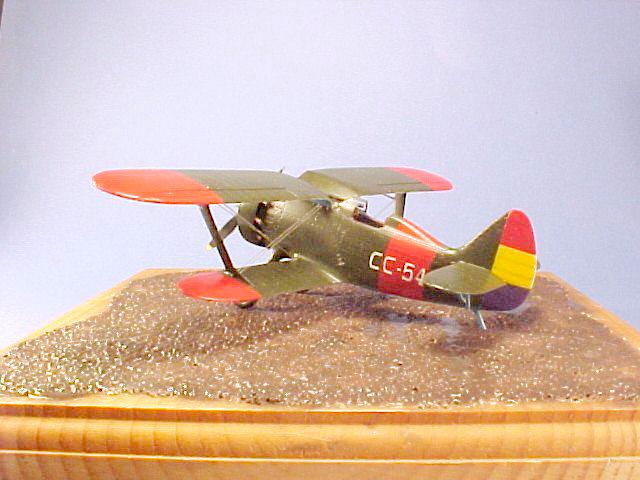

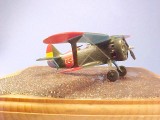
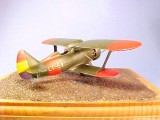
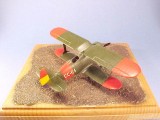
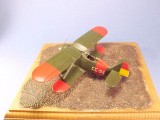
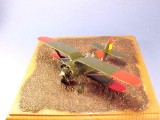
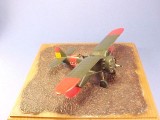
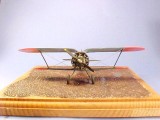
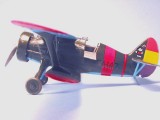
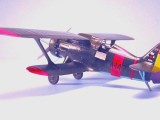
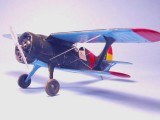
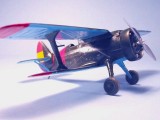

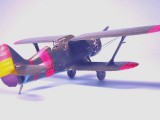
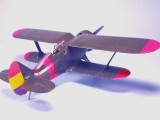
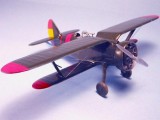
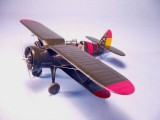
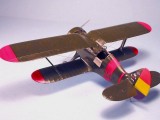

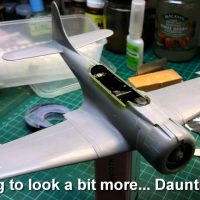
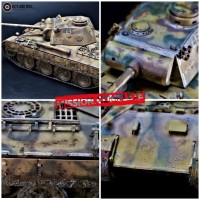
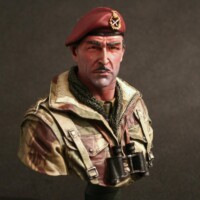
Cool models, that is nice for a Vac. This airplane is a fave of mine too. Now that I look at it, maybe the "Curtiss" identification came from the gull wing, also used on the Sparrowhawk parasite fighter?
That's certainly the most likely explanation. The Sparrowhawk is the only Curtiss design that vaguely resembles the I-15.
Well done Tom, obscure subject from a mostly forgotten war. Your narrative brings to mind the lurid and I suspect wholly fictitious tales of aerial duels in Spanish Civil War in Martin Caidin's "Ragged Rugged Warrior's". He could surly spin a yarn.
Yeah, but the difference between his and mine are that mine are factual.
I have spent a good 1/3 of my aviation historian career correcting his stuff (spent 45 minutes on that out at Chino today, correcting his stuff about P-38s). The man may have almost single-handedly created "aviation history" as a field of writing, but sure as hell he never let a fact get in the way of his idea of a good story.
Indeed he did not. Nor above flagrant plagiarism, to put it mildly. I'm fortunate enough to have a copy Sy Bartlett's 12 O'Clock High, and while reading it, realized that large portions had been lifted and used in Caidin's "Flying Forts" & "Black Thursday". Regardless of all that, he did set a fire in my teenage mind that has burned for 45+ years to learn about the men that gave life to the planes I was consumed with back then.
Yeah, that's why I have never advocated hanging him for his crimes against writing (unlike Fenimore Cooper, who I once had to adapt for a screenplay. Mark Twain was right in "Fenimore Cooper's Crimes Against Writing.")
Enjoyed that brief history of Czech companies. Nice models too.
A great build and a highly informative and interesting written story !
TC,
You could have named several plastic kit manufactures (choose your poison) and would have gotten away with it saying that the kits are plastic. These builds are impressive to say the least. Great article and the history of Czech modeling too. I always lament on how we in the states or our business men have opted to out source all of the kit manufacturing and the innovation ( like Monogram did) while the Czechs have kept things in house and have gainfully employed their fellow country men,while pushing the hobby forward. Sort of like having people who are modelers and business people doing what they love first vs folks who are bean counters and are interested in their spread sheets and returns only. They're grabbing the horn by the wrong end and there is a disconnect.
Sort of like having people who are modelers and business people doing what they love first vs folks who are bean counters and are interested in their spread sheets and returns only. They're grabbing the horn by the wrong end and there is a disconnect.
You are so right, and not just about models. 30 years ago, movie studios were run by people who actually like movies; today, they're minor arms of intergalactic widget-makers, who don't want to know that the three rules of Hollywood are: Nobody. Knows. Anything (no, they're not stupid, but nobody knows for sure what's going to be a hit till the Monday morning after opening weekend; it's all a crapshoot). But widget-makers don't want to know that, which is why they now make dog kibble and tell people it's steak. It's the same thing everywhere. I had the privilege of being friends with Corky Meyer, former CEO of Grumman, who started as a production test pilot. I knew Ben Rich (creator of the SR-71) at Lockheed. They were all Airplane Guys. Back when I was a kid, I wrote to the major airplane companies and said I wanted to know about their airplanes; I received beautifully-written, beautifully-photographed material. For free! They all knew that being an "airplane guy" was a virus and it was spread by contact. And then, 40 years ago, the @#$%$#@#!@! MBA came along. Bean counters. They knew the price of everything and the value of nothing. Airplane guys, car guys, movie guys, you-name-it guys, they all got replaced by the @@#$%$#@@! MBA spawn of satan scum.
And that, ladies and gentlemen, is why we're in the toilet.
Tom,
Good info and good looking models. No beans about it